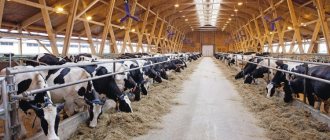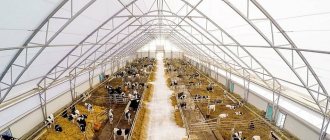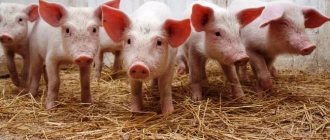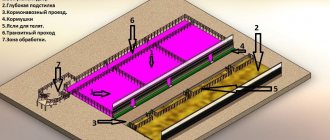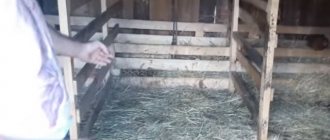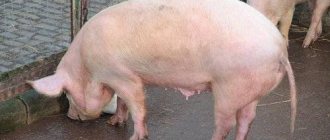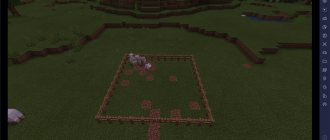Characteristics of a barn for 200 head of tether housing
The main feature of a 200-head tethered barn is that the cattle are tethered. It is necessary to organize stalls in such a way that the animal can lie down, stand up, make head movements without interference, and also eat and drink without restriction of movements.
In addition, the harness should be positioned so that the cattle cannot stand up and lie down across the stall, or step with their hooves into food troughs or manure pits. Cows can be milked either in the stall itself or in a separate room.
The 200-bed facility is suitable for most small livestock farms. The specifics of building a barn will depend on the size of the room and its design features.
Livestock are usually housed in 4 rows. In this arrangement, the cows standing in the outer rows turn their heads towards the wall, and in the remaining rows, located in the middle, they look at each other.
Less commonly, you can find options with placing animals in 2 and 6 rows, as well as with transverse and circular placement. The main condition when organizing stalls is the comfort of the animals and the ease of their maintenance. Staff should be free to approach stalls to fill or replace feeders, remove manure, etc.
Automation of drinking
You can learn more about the types and selection of automatic drinkers from our article “Automatic drinker for a cow.”
Today we will talk about the electrical costs of such equipment, and what needs to be taken into account when calculating energy costs and why they should be produced at all. To fill a waterer for a large herd, you will need a powerful pump. A good option for such equipment is the EKV 6-4-90 model, which supplies from 3 to 6 cubic meters per hour. The pump is equipped with a powerful PEDV 2-140 motor. Its power is 2 kW.
To determine how much electricity will be consumed, you need to make the following calculation: find out how much liquid is needed to provide 200 heads. One cow consumes 65 liters of water per day. Multiplying by 200, we get that a large barn needs 13,000 liters or 13 cubic meters per day. m. In an hour, the automatic drinker delivers an average of 4.5 cubic meters. m of water, therefore 13 cubic meters. m we will receive in 3 hours.
Electricity consumption per hour – 2 kW. This means that the drinker consumes 6 kW of electricity per day.
Features of this type of barn equipment
The outer edges of the stalls are equipped with special wooden stall frames or metal pipes to which the harness is attached. It must be strong and durable, as well as convenient so that cattle can be quickly tied up and untied. Stall equipment, depending on the method of tying and untying, can be individual or group.
There are two types of stalls in barns:
- short, the width of which is 1100-1200 mm. They are designed for young animals, dry cows and heifers;
- long, where the width reaches 1200-1500 mm. They house bulls, pregnant and highly productive cows.
An important point in organizing a barn is the correct location of the manure area. It should be located at a slight slope from the feeders.
Windows in a barn for 200 stalls are usually made with double glass. The lighting rate in such a place is 1/20, in relation to the area of the windows to the surface of the floor covering.
Feeders and drinking bowls for animals can be individual, i.e. in each stall or in groups, designed for several individuals at the same time.
The barn can be one-story or have several floors. In such premises there must be utility rooms where cows are milked, equipment is stored, etc.
Construction stages
The construction of any barn, even a small one, takes place in several stages:
- Building design
- Laying the foundation
- Walling
- Roof of the room
- Flooring
- Organization of ventilation and lighting
- Arrangement of the barn
The construction project is carried out taking into account a number of factors: comfort, environmental safety and financial efficiency.
After drawing up the project, they begin to lay the foundation, which can be monolithic, strip or columnar. The type of base depends on the material of the walls. So, for the construction of a brick shed it is better to use a monolithic foundation, and for a wooden one - a columnar one.
The construction of a monolithic foundation includes:
- Digging a trench, 50-70 cm deep;
- Installation of formwork with reinforcement;
- Laying a cushion of crushed stone or sand;
- Pouring concrete mortar;
- Waterproofing the dried surface using roofing felt or roofing felt.
A columnar foundation is built in a similar way, but the foundation pillars are poured into forms with reinforcement, insulated with roofing felt. The distance between such pillars should be no more than two meters.
For any type of foundation, waterproofing and the presence of a water ramp are mandatory. Therefore, the outer edge of the foundation must be covered with a sand-crushed stone layer, and the base itself must have a waterproofing slope.
The construction of walls begins on a protected foundation made of materials that retain heat well. It can be either wood or brick (regular red or adobe). Wooden walls are warmer than brick walls, but their service life is quite limited. Although brick walls require additional insulation, they provide good ventilation. Adobe brick retains heat well and ensures dryness in the room. Foam block and sand-lime brick are excellent for building a large barn and do not require large material costs, but a wooden structure will cost more.
Experts recommend covering a small shed with a gable roof, which is not only more stable, but also retains heat due to the attic. In addition, the attic serves as an excellent hay storage all year round. The version of a shed without an attic is easier to build. In this case, boards are tightly laid under the roofing material (slate or roofing felt), the joints of which are sealed with clay mortar. The surface of the boards is covered with a layer of insulation (dried sawdust, slag, dry soil) up to 10 cm thick. Slate or roofing material is used as roofing material, which are laid so that water does not flow under the eaves.
An important condition for a properly built barn is a comfortable floor. In other words, it must be waterproof, warm and easy to clean. The most optimal material for the floor is called baked brick, which is more durable than wood and not as cold as concrete. The concrete floor must be covered with bedding (wooden panels) to prevent the animals from freezing and getting sick. Laying the floors is preceded by compacting the soil and laying a layer of roofing felt or slag. The floors themselves should be located 10 cm above the ground level. You should also provide a slight slope of the floor (a difference of 2 cm per 1 linear meter) for the natural drainage of waste into the gutter.
In order for pets to feel comfortable and please their owners with high milk yields, it is necessary to take care of ventilation and lighting levels. The ventilation system can be built independently in the form of an exhaust pipe with a special damper or a box made of boards (15x15 cm). The outlet of the ventilation system is located above the level of the roof ridge. Windows can also be used to ventilate the room. However, in this case, it is necessary to ensure that the animals are not exposed to drafts.
The required level of lighting is achieved through windows, which must be located at least 100 cm from the floor so that the cow cannot catch them with her horns. The optimal window area is 10 times less than the window area. In addition, it is recommended to plaster and whitewash the interior of the barn to accumulate sunlight.
Arrangement of a barn involves the installation of feeders and drinkers, both group and individual, as well as the organization of a paddock for walking. Such a walking area is usually located outside the building. In this case, the total length of the walking path for each cow must be at least 500 m. The area itself must be fenced and covered with a canopy.
Lighting
An important issue in electrification is lighting in the main hall of the barn where the animals are kept. Lighting allows you to extend daylight hours, which affects the productivity of animals. Daylight hours must be at least 16 hours. At the same time, for a stall room the lighting standard is 10 lux per 1 m2. It is necessary to install such a number of lighting fixtures that the standards are met.
For the calculation, the following indicators are taken into account:
- room area; for a barn for 200 heads it will be approximately 300 m2;
- height of lamps; if the ceiling height is at least 3.5 m, then taking into account the ventilation lines, the lighting device is hung at a height of 2.7-3 m;
- dirtiness of the room and reflection coefficient from the floor 10%, from the walls 30%, from the ceiling 50%;
- select the type of lamp; Lumens are taken into account here; LED devices are recommended; IHB100 and ISK50;
- the luminous flux should be distributed evenly throughout the room, so the location of the lamp will not be central, but point-like across the entire area of the room;
- for livestock complexes, devices with 8500 lumens (Lm) are recommended.
When calculating the electrical equipment of a barn, special formulas are used. Online calculators are designed to make calculations easier. According to the calculation results, a room for 200 animals requires 9 lighting fixtures of 30 thousand lumens. They are located along the central aisle.
To ensure a uniform light flux, the lamps are strengthened in 6 m increments. If the barn is built with a 4- or 6-row line of stalls, then the lamps are installed in all aisles. Their number does not change. Additionally, side lighting is provided. Lamps of 4 thousand lumens are used. You will need 92 of them. The devices are located along the entire perimeter of the barn.
Lighting is provided in the milking parlor, in the feed distribution area, in the staff room, and in the raw material storage area. For milking parlors, maternity rooms, and calf barns, lighting standards will be different. This must be taken into account when calculating the number of lamps.
- calf barn – 15 hatches at floor level per m2;
- milking parlors – 30 hatch;
- rooms for artificial insemination – 70 hatch;
- stables – 5 hatch;
- pigsties – 15 hatch.
For barns, choose lighting fixtures that have a protective coating against aggressive chemical environments. After a short time, the devices will become covered with dust. They need to be washed.
Often when cleaning, a strong stream of water is used to clean the lamps. When purchasing a device, you must take into account its tightness, resistance to moisture and mechanical stress. The lamps are installed on rigid brackets.
If the LSP-2*40 device was chosen for lighting, then 30 pieces will be needed to illuminate the stall area. 9 of them are arranged depending on the line of the barn, in 2, 4, 6 rows. The rest are installed around the perimeter of the room. In the project for the barn, calculations are made of light and power wiring, input power, electrical network layout, and grounding system.
More on the topic: How are a herd of cows divided into groups?
Why is it easy to implement a mini-farm project?
Many aspiring entrepreneurs choose a mini-farm among all the business ideas for family enterprises. This is a profitable business: each cow produces at least 5,000 liters of milk per year. If beginning farmers do not have sufficient funds to start their own business, then future businessmen can turn to the state for help. Financial support is provided to projects on a competitive basis.
To win, you need to present a well-drafted business plan, which is based not only on enthusiasm and the desire to earn money, but on specific calculations.
Beginners in business should not strive to write grandiose projects if they have not yet earned anything. The subsidies given to the winners have limitations: the money received is only enough to buy 25 or 30 cows.
Therefore, there is no point in writing a project designed to purchase a larger number of livestock - 100 or 150 units. In various regions, subsidies are allocated for certain amounts sufficient to implement the project of their own farm for entrepreneurs who are just starting to work for themselves.
For a family business, this option has proven itself to be excellent:
- Everyone who works on the farm does not need to travel by public transport in the morning: the place of work is located near their home.
- When members of the same family are engaged in a common cause, they become more united.
- The automated complex requires simple maintenance. To operate it, you do not need to be a certified specialist.
- Communication with pets has a positive effect on the human psyche.
An example of a small home farm made from scrap materials - To develop a plan for the development of your business, you can use the positive experience of other entrepreneurs who keep 100 units of livestock or more.
- If desired, you can repurpose the business. If initially the farm produced exclusively dairy products, then after some time it is possible to establish meat production.
- The demand for milk and meat products is constantly growing, which guarantees the prosperity of private business.
Today, implementing a farm project has become available to everyone. However, during the design stage, think about every step you take. Postpone the construction of metal outbuildings for the future if there are not enough funds.
Your business will soon pay off completely. The main thing is to think through all the nuances in advance; only under this condition will a new businessman be able to become a reliable supplier of high-quality products of his own production.
All that remains is to maintain your brand, which will allow you to gain your clients. When people are confident that they will be offered only good products from family farms, they will come back to shop again.
Feed distribution
The total power supply of the barn is calculated taking into account the automatic supply of animal feed. For this purpose, a conveyor belt is used. The equipment requires a separate calculation of electrical supply.
Feed dispenser
When choosing a feed dispenser, the following needs are taken into account:
- number of heads in the herd: 200;
- single feed consumption rate: 16 kg per 1 individual;
- distribution time – 20 t/h.
By studying the characteristics of the equipment provided by the manufacturer, they can conclude whether the feed dispenser will be effective for supplying feed to a large number of animals. TVK-80B equipment fits these parameters. Its productivity is 38 t/h, the number of livestock served is 100 heads, the length of the feed chute is 74 m. The power of the device is 5.5 kW. Requires an electrical voltage of 220 V.
Choose a feed dispenser RK-50. The conveyor is located above the feeders. Its productivity is 30 t/h, designed for 200 heads. Power 9 kW. Belt length is 75 m. A separate electrical system for the chopper and feed loader is prescribed if the processes are automated.
Feed dispensers can be powered by an AIR100L2U1 engine, PML-262102 engine starter: “start” and “stop” button. Thermal relay RTL-101604, a way to regulate current 9.5-14 A. It is installed on the drive of the feed conveyor. Before accepting equipment, its performance is calculated. To drive the waste collection conveyor, use an AIR90L2U3 engine, a PML-122002 starter, an RTL-101204 relay, 7-10 A. Automatic switch AE 2046.
Water supply
Watering cows on large farms is fully automated. With the tethered method of keeping cattle, individual drinking bowls are installed in the stalls. For free-stall keeping of animals, common drinking bowls are installed. Water is supplied to them from a central reservoir through a pipeline.
In general drinking bowls, filling occurs due to a float device. Individual bowls use a valve to supply water. The animal approaches the bowl, pressing the valve with its head, water is supplied.
| № | Helpful information |
| 1 | PE-2 – used for general watering of cattle. The drinking bowl is designed for 120 heads, volume 140 liters. Heater – 270 W |
| 2 | AP-1A – individual drinking bowl. The bowl is placed between 2 stalls so that 2 individuals can drink at once. Volume 1.85 l. Heating in a total capacity of 270 W. Assumes 80 liter tank |
| 3 |
More on the topic: Why does cow's milk taste sweet?
To ensure that the water in the drinkers remains warm for a long time, they are placed in thermal pipes. They are made of plastic. They have double walls and thermal insulation. The drinking bowls are connected via a SUEVIA 230/24 V transformer.
Automatic manure removal
The electrification of a 200-head barn provides energy for automatic manure removal. An adult cow excretes 40 kg of feces. Automatic devices are used to remove manure and dirt in a large barn.
To clean passages, delta scraper units, scrapers, and conveyors are installed. The equipment runs on electricity. For stall housing, scraper conveyors are used. They are able to remove large dirt and feed it into the manure receiver up or down to the drainage pit.
- TSN-160 – chain length 160 m; installed on the bottom of drainage channels located on the far side of the stall; the equipment requires an electrical control cabinet TSG-01-300; powered by AIR112M6 engine;
- TSN-2B – designed for cleaning stalls; collects manure into a trough, conveys it upward along the conveyor; electrical control cabinet TSG-01-300; motor 4 kW 1000 rpm;
- UFS-170 – delta scraper unit; chain 170 cm; recommended for a room 80 m long; drive station USG.00.010; motor 1.5 kW, voltage 380 V, AIR80V4;
- USF-250 – gearbox USG.00.010; designed for cleaning a barn 114 m long; electric motor AIR90L4.
The electrical control panel is installed at a height of 1000 mm from the floor. It is reinforced with bolts and concrete pouring. The cabinet is made of 3 mm steel. Measuring instruments: ammeters, voltmeters are installed in the upper part. Switches, fuses, meters are on the back wall.
Devices of the same circuit are arranged in a vertical line. This is necessary so that when the fuses blow, the arc does not capture other devices or connecting busbars. Switches are located in different vertical planes. The distance between phases is 100 mm.
Security
There are many electrical devices in the barn: motors, power cabinets, panels. Heaters are located in drinking bowls and water containers. All devices must be safe for both operating personnel and animals. It is required to ground the housings of all electrical installations. Why is this necessary if the devices are securely enclosed in housings?
Grounding barns is necessary not only for safety reasons from electric shock. If a short circuit or breakdown occurs, the current will flow through the metal objects of the barn: pipes, partitions in stalls, metal feeders, drinking bowls, conveyors. To prevent this from happening, electrical outlets are made. They are connected to all metal objects and to the ground. The current will follow the path of least resistance, through the tap. A separate system is provided to protect the building from lightning strikes.
Grounding of devices is carried out in a place inaccessible to animals. Do not install the system in passages, near stalls or in animal resting areas. Choose a protected area that is clearly visible and has access for repairs.
More on the topic: What is cow launching and how to do it?
To protect animals from electric shock, metal conductors, wire or tape are placed on the floor of the barn. They are connected to metal partitions, feeders and other elements. Connections are made by welding. The peripheral conductors go to the central metal rod. Its length is ½ the length of the stall. Diameter – 12 mm.
The protective conductors in the power cabinet or in the central panel are connected to the triangle of the repeated grounding loop. To do this, use corners 5 * 5 * 0.5 cm. Between them there is a steel strip - 4 * 0.4 cm. The distance between the electrodes is maintained at 2.5 m. It is buried to a depth of 0.5 m.
Calculation of the area and diagram of the barn by the number of heads
The size of the barn is determined by the number of livestock, the way the animals are kept, and the need for utility rooms. The approximate area of the barn with your own hands should be calculated depending on the number of heads. Initially, a drawing is created for a standard barn, on the basis of which a step-by-step design of the future layout begins in accordance with European standards for keeping animals.
During the planning stage, it is important to consider the use of every square meter in order to maximize the limited area.
The area of the barn directly depends on the volume of livestock, as well as the number of rows in the room. For small farms, the optimal area for 1 head is 10 m2, and for large farms it is about 6 m2. The stalls are always organized in a row manner. The maximum number of cows in one row is 50. The table shows the approximate dimensions of the barn for different numbers of cattle.
| Livestock | Area, m2 | Number of rows |
| 10 | 100 | 1 |
| 20 | 200 | 1 |
| 30 | 300 | 1 |
| 50 | 500 | 1-2 |
| 100 | 800 | 2-4 |
| 200 | 1200 | 6-8 |
| 300 | 1800 | 6-8 |
| 500 | 3000-4000 | 8-10 |
| 1000 | 6000-8000 | 8-10 |
Designing an area according to Euronorm dimensions
The barn is traditionally shaped like a rectangle or square, which increases the capacity of the building. The height of the room should be at least 2.2-2.5 m, but when using an attic the size increases. Each animal requires at least 6 m2, and a cow and calf require 12 m2. In practice, the pasture-stall housing method is most often used, so it is necessary to provide space in the barn for each cow. The average size of a barn is 100 m2; this area allows for the expansion of the animal population, as well as accommodating all the necessary outbuildings.
Barn project
If you intend to build a small barn for 10 head of cattle or even less, then you can draw up a project yourself. Of course, for this you still must have at least basic knowledge both in the field of construction and in the organization of livestock farms. Without this, you are guaranteed to make mistakes in the project, due to which the barn will be not as functional as planned, or completely unusable.
If we are talking about a fairly large livestock complex, and you need a barn for 100 heads of cattle or more, then you can’t do without specialists who have the necessary experience in designing such facilities. Professionals will certainly take into account a bunch of different little things in the project that you don’t even know about, but ignoring which can bring a lot of trouble later.
An important stage in drawing up a project is determining the construction budget. If you are ready to spend a million rubles on construction, then this will be the simplest barn for a small number of animals. But if you have 20-30 million, you can choose a larger and more progressive project based on the use of modern building materials and technologies. Thus, without deciding on the construction budget, it is impossible to begin drawing up a construction project.
The second most important parameter that directly affects the barn design is the planned number of livestock. The total area and size of the barn depends on it. With loose housing, one cow needs an average of about 6 square meters. m of area, and for a cow and calf about 10 sq. m. However, most farmers practice the tethered method. In this case, the animals are kept in individual boxes (stalls) with the following dimensions:
- for one adult cow - width 1-1.25 m, length 1.75-2.15 m;
- for a cow with a calf - width 1.5 m, length about 2 m;
- for calves - width 1 m, length 1.5 m.
- for a bull - width 1.25 m, length 1.4 m.
Grown-up young animals are usually kept in common calf barns without a leash. The area per calf up to one year is about 4 square meters. m, older than a year - 4.5 sq. m.
These calculations are approximate, since, firstly, there are other standards for area per animal, and secondly, the area of technological passages and office premises must also be added to the area of stalls and pens.
In addition to floor area, barn design must also pay attention to ceiling height. For comfortable keeping, animals need about 2.5 meters of space from floor to ceiling
If the ceiling is lower, the room will be stuffy, if higher, the barn will cool down faster in winter.
Business plan (to build a good wooden or frame barn, costs for young animals, feed)
The cost of maintaining and raising cows for meat is determined by many parameters. This is the area of the territory, the number of livestock, materials for the construction of the barn and the costs of feeding and servicing the animals. At the beginning, significant costs will always be required, which will begin to pay off only after several calvings, since proceeds from the sale of dairy products can only partially cover the costs of maintaining cattle.
Read the business plan for cattle breeding here.
Costs for the workover device
Setting up a farm and purchasing the first livestock of animals and feed for them requires significant financial investments. The primary costs for organizing a cattle breeding business are:
- Land lease . The price directly depends on the area. In fertile areas with a mild climate, the cost of rent for farming needs is always higher. It is advisable to acquire the necessary space over time, which will significantly reduce costs. To raise 100 heads of livestock, at least 1 hectare of territory is required.
- Construction and equipment of a cowshed . This is one of the largest expenses at the beginning of production. It is profitable to build a shed on your own without hiring third-party workers. The cost of construction depends on the area of the barn and the automation of the process. Most often they resort to modern prefabricated standard barn layouts, where all the necessary communications are connected: water supply, electricity, sewerage, ventilation, etc.
- Purchase of animals . Initially, it is advisable to purchase several adult cows and bulls, as well as 10-12 heads of young animals. You should not immediately buy purebred and breeding animals, since most often they require special maintenance;
- Purchase of feed . It is purchased based on the number of livestock, the season of the year, and also taking into account the required feed. In summer, food costs are lower, since grazing is possible. In addition, you should immediately purchase all vitamins and feed additives;
- Hiring workers and paying wages . Self-maintenance of a farm with more than 15 cows is physically impossible. Therefore, it is necessary to hire employees to clean the premises, care for animals and collect products. The cost of veterinary care must also be included in the estimate.
Read about the feeding diet for dairy cows here.
The costs of setting up a business vary greatly depending on the location. In the southern and eastern regions, raising cows is cheaper, but it is important to understand that there is more competition in the market in these areas.
Profitability
Raising cattle is a profitable business, but this condition applies only to large farms with established sales channels. In the early stages, you will need to invest at least 1 million rubles for the arrangement of premises, the purchase of animals and feed. On average, the farm's payback period occurs no earlier than in 1.5-2 years, provided that meat and milk are constantly sold and new animals are purchased. Profitability largely depends on the productivity and health of livestock. If you create the right conditions, you can subsequently receive a stable income from the sale of replacement young stock, especially when raising productive breeds of cattle.
Read about keeping a cow on a private farm here.
What is a mini-farm?
Mini-farms include farms that keep cattle. Livestock breeders receive and sell dairy, meat and other products.
Interior arrangement of a private mini-farm
In livestock farms where they are already making a profit, the average number of livestock ranges from 50 to 100 units. The project allows us to increase production volumes and increase productivity in the future. At the same time, any Russian family will be able to open their own business, since fabulous funds are not needed to purchase cattle, erect outbuildings, or open an individual entrepreneur.
Standard design device
Any barn project must include the required elements:
- stall;
- kitchen where food is stored;
- manure collection sector;
- walking area;
- section where calves are born;
- boiler room, which heats all rooms;
- compartments for placing containers of milk;
- room for various equipment.
Enough free space must be left between sections
Stall sections are usually arranged in at least two rows. Each of them must be equipped with a feeder, drinking bowl and waste drain.
Types of cow sheds
If we consider the material of construction, the barn can be:
- a room made of metal profiles, where the room temperature is identical to the street temperature;
- construction made of heat-insulating material;
- hangar based on sandwich panels.
There are several types of barns depending on the design of the premises:
- a 2+2-row barn, in which a high trapezoid-shaped roof is made of a metal profile, and inside there are side walls with curtains;
- 3+3-row barn, characterized by the presence of a “carousel” milking row and a separate building for storing milk;
- 3-row barn, where the milking area and the calf room are in the same room.
Preparing to build a house for domestic cows: drawing up a project
The primary task at this stage is to choose a suitable location for future construction. You need to understand that the area of the special building must be enough for both cows and calves. Whatever the number of livestock that will be kept in the barn, construction work begins no earlier than a building plan has been drawn up on a piece of paper.
Designing a barn begins with calculating the area. For this purpose, standard norms for a barn are taken as a basis. The height of the traditional building for cows is 2.5 meters, and the area is 4x6 meters.
A cow on a leash should not be cramped
When kept free-stall, each cow in the barn is provided with about six square meters. If a female gives birth to a calf, she will need a little more space - about ten square meters. It is recommended to keep older calves separately from the adult stock so that they grow well and become stronger. Therefore, when building a barn, it is necessary to provide for the presence of a special room.
However, more often farmers keep animals using the tether method. It involves the creation of individual boxes. The size of the stall depends on the sex and age of the animal. One adult cow needs a space of 1x2 meters, and a bull needs 1.35x1.95 meters. It is customary to provide a cow with a calf with a stall one and a half meters wide and two meters long. A grown cub will be comfortable in an area of 1x1.5 meters.
Grown calves can be kept without a leash. In this case, 4–4.5 square meters must be allocated for each calf.
Young animals are kept separately from adults
The size of the warehouse for equipment and feed will also depend on the number of cows stocked. Keep this in mind when designing your barn.
Layout of a barn for 30, 50, 100 and 200 heads
A household usually has no more than 30 cows. For such a large number of animals, drawing up a building plan is quite simple.
In such a room, 10 separate sectors are created
If farmers have time to care for a large number of cattle, then they might consider building a 50-head barn.
The plan reflects all sectors of the building
It is better to entrust the construction of buildings for 100 or 200 cows to professionals.
Top and side views of the building should be on the drawing
Only a master (or a whole team) can handle the construction of large premises.
A large barn should be depicted from all sides
What material to choose for construction
To build a barn you will need:
- crushed stone placed in the pit as material for preparing the building platform;
- durable concrete or baked brick, which can withstand significant loads: it is used as a raw material for the construction of a barn platform;
- waterproofing material, for example, roofing felt, serving as a bedding;
- composition for creating a concrete or asphalt platform necessary to protect the walls of a building from rotting;
- adobe brick, from which walls are built: it perfectly retains heat in a room (it is made from durable clay) and is inexpensive;
- wooden boards used as flooring, or concrete: unlike wood, it does not wear out;
- slate for the roof.
For the construction of wooden walls, boards with a thickness of at least five centimeters are suitable. Therefore, it is more logical to make a log barn. If the barn is made of brick, you should take care of its insulation.
Foam blocks can also be used to build a barn. This material allows you to quickly erect walls, and is also ideal for creating optimal conditions for keeping animals with the ability to maintain the required temperature.
List of required tools
During the construction of the barn you will have to use:
- shovel;
- crowbar;
- self-tapping screws;
- building level;
- rope.
When building walls made of bricks or blocks, you will additionally need a trowel and a spatula. You will also need a mixer with which to prepare the cement mortar.
Basics of building construction technology
The construction of a barn for a mini-farm is carried out according to the following plan:
- digging a pit for a strip foundation;
- pouring the base (necessarily with reinforcing mesh);
- walling;
- installation of floor beams;
- roof assembly;
- installation of windows and doors;
- connection of communications.
The barn can be solid or frame. For the foundation, concrete on a sand cushion is used. Immediately consider the angle of the floor.
Use metal or concrete for flooring, and brick, foam concrete or wooden beams measuring 10x15 cm for walls. A frame building can be covered with sandwich panels (especially in cold regions). A gable roof is preferable - snow and water flow off it more easily. Roofing materials - roofing felt, slate, corrugated sheets.
Advice. The attic will make the room warmer. The floor on it is made of boards, which are covered with a layer of sand.
Materials for the barn must be durable and environmentally friendly. This way you will create a good microclimate indoors. And it, in turn, is important for effective cattle breeding.
How to build a barn with your own hands: step-by-step instructions
There are two ways to build a barn: with a frame and without. Experts recommend the first option, because it allows you to easily install communications into the building, install water supply, ventilation and manure removal systems, and install lighting devices. In addition, the frame structure is much cheaper.
The construction of a small barn occurs in several stages:
- The top layer of soil is removed from the land plot. Crushed stone is poured into the resulting pit. When building a frame barn, arranging a foundation as such is not required. This completes the installation of the base. In the case of a brick building, a strip concrete foundation is poured. To do this, a trench about one meter deep is dug along the perimeter of the barn. Next, formwork is constructed, which is filled with liquid concrete. Waterproofing material is placed on top of the frozen foundation, and bitumen is placed on top.
The foundation pit is filled with crushed stone, formwork is made and poured with concrete
- At each corner, using a building level, lay several rows of bricks.
Next, install the vertical bars. They are leveled and stapled to the bricks. All rows of masonry are marked, after which a cord is pulled, which helps to lay all other elements of the building strictly horizontally. The first row of one brick should be butted so that the walls are well connected to the foundation. They are laid until the height of the building reaches two and a half meters. When doing masonry, do not forget to leave openings for doors and windows. In addition to bricks, other materials can be used to build the walls of the barn, for example, foam blocks - Logs are laid at the top of the building to serve as support for the wooden roof deck. The created sheathing is covered with roofing material.
- They move on to interior work: pouring the concrete floor. It must be made inclined so that animal excrement immediately falls into the drainage hole. Floorboards are laid leaving gaps of one centimeter. It is advisable to make the wooden flooring sectional, which will allow it to be lifted and thoroughly cleaned.
The construction of a barn for large livestock is carried out according to a similar scheme. Bedding must be placed on top of the wooden floor - sawdust and straw. Otherwise, livestock may freeze and get sick. In a barn for 100 or 200 heads, it is very important to equip a manure removal system to avoid the accumulation of urine and feces.
Cows can rest on straw bedding
A barn housing 200 animals will have to be ventilated frequently. To do this you will need to build a liftable canopy. When building a barn for a large number of livestock, each stall must be supplemented with a feed trough 65 centimeters high and 1 meter long.
How to make ventilation in a barn
A natural ventilation system, which is considered the simplest option, is usually developed before the construction of a barn. When the project is ready, you will need:
- Create intake holes in the lower part of the building, almost at the very foundation, into which fresh air blown by the wind will flow.
- Using pipes, construct holes to remove stagnant air, located above the roof of the building in the direction opposite to the intake holes.
- Equip the inlet openings with dampers, and the outlet openings with a hood deflector.
Fresh air enters through the walls, and exhaust air leaves through the roof
Manure removal system
The system for removing manure from the barn is thought out in advance. To do this, install:
- self-alloy;
- hydraulic flush;
- band conveyer;
- delta scraper.
Livestock feces are removed by a special device
Typically, farmers resort to a self-rafting system, that is, pipes covered with slippery material are laid at an angle throughout the entire area of the barn for cows. Tees equipped with special plugs are mounted on them. When these “doors” are opened, manure flows into the tank.
Lighting in the barn
There are certain lighting standards for different rooms in the barn. In stalls this parameter should be 50 lux, in the feeding area - 75. In this case, lighting fixtures should be located at floor level. So that production indicators do not fall, but grow, it is necessary to create lighting in the barn of 200 lux and no more than that.
It is better to install LED lamps in the barn, since fluorescent lamps do not function in cold rooms. When the temperature is below optimal (20–25 °C), these devices provide low-intensity light.
Design
Building a barn that can not only accommodate a hundred cows, but also provide them with conditions for a comfortable life is not at all as simple as it might seem. And you will have to spend a lot of money during construction. It is for this reason that it is worth doing everything to eliminate any errors. After all, eliminating even the smallest ones will certainly result in a serious waste of time and resources. If they are not eliminated, then you may encounter various troubles – even the death of animals.
That is why it is best to trust the design to specialists. They are well versed in building materials, know what conditions are optimal for keeping animals and will be able to design exactly the kind of room you need.
The first consideration when designing a deep litter freestall barn is size.
note
8x16x50 meters is considered optimal. That is, the height at the highest point is eight meters, the width is 16, and the length is 50.
Yes, this is somewhat larger than a tether barn, but the animals get the opportunity to move, which has a positive effect on their well-being. If you reduce the size, the animals will be too cramped. But if you increase it, this will lead to additional expenses during construction, besides, the cows will not be able to warm the room with their heat and will suffer from the cold, or they will have to spend extra money on heating the room.
Also, we must not forget about the correct location. When choosing a place to build, you should remember the following requirements:
Proximity to the road. Otherwise, transporting cows, milk and dairy products will become significantly more difficult. Great distance from residential premises. Each cow produces tens of kilograms of manure per day. Of course, even the presence of good ventilation does not eliminate a very unpleasant odor, which can cause a lot of problems for the inhabitants of houses. The openness of the area follows from the previous point. Good ventilation when properly ventilated often makes the installation of additional hoods unnecessary. Availability of the necessary infrastructure. It should be possible to supply electricity to the barn, and in some cases also gas and water if you plan to use gas heating boilers
This is most important for the northern regions, where the climate is especially harsh. Flood protection. Do not forget that in the fall, during the rainy season, and in the spring, with abundant melting of snow, the lowlands are flooded
Therefore, it is advisable to locate a cattle shed on slightly elevated areas, eliminating the possibility of a flood.
If we take into account all these requirements, then when keeping cows there will be no unnecessary problems for either the animals or the owner.
